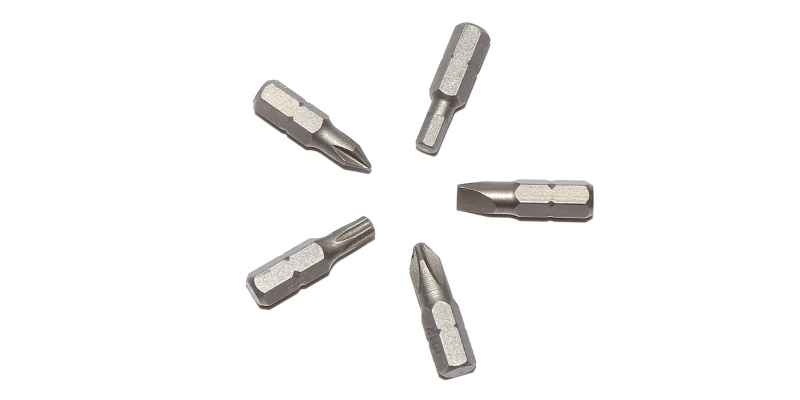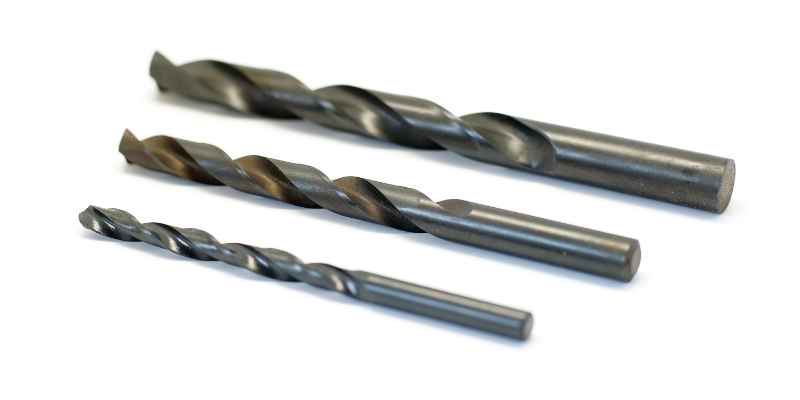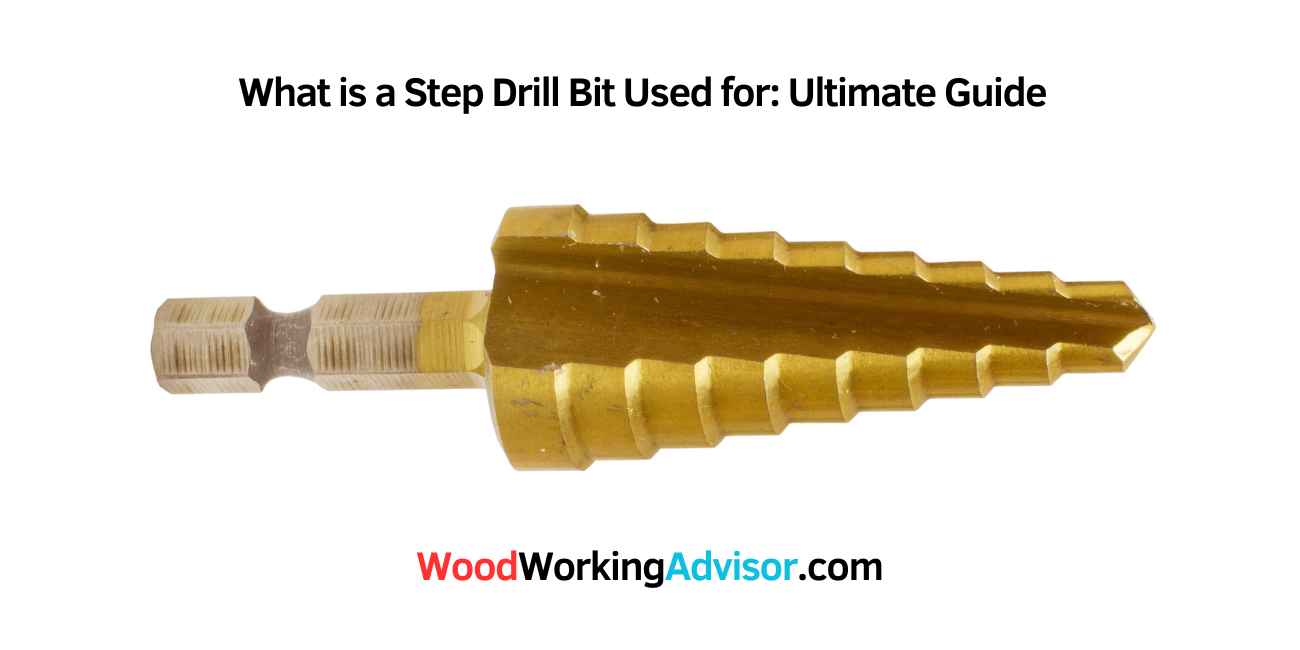A step drill bit is used for drilling holes in various metals, including steel, aluminum sheets, and non-ferrous metals. It can easily create circular holes of different sizes without swapping out drill bits as often and is faster than standard twist drill bits.
The main advantage of using a step drill bit is that it prevents material from clogging the pilot hole while drilling. However, one limiting factor of the step drill bit is that it is only suitable for cutting thin materials, such as sheet metal.
Despite this limitation, step drill bits are highly useful for various applications, including drilling in plastics and dealing with sheet metal deformation. We will discuss the uses and applications of step drill bits, their advantages and disadvantages, and when and how to use them.
Introduction To Step Drill Bits
Step drill bits are uniquely designed to create holes of varying diameters without the need to change bits, making them a versatile tool for various drilling applications.
The basic components of a step drill bit include a conical tip, multiple step-like cutting edges, and a shank for attachment to a drill.
Versatility In Materials
A step drill bit is used for creating holes in various materials like metal sheets, wood, and plastics. Its unique design allows for drilling different-sized holes without needing to switch bits frequently, making it efficient and versatile for various applications.
Metal, plastics, wood, and more – a step drill bit is a versatile tool that can handle various materials with ease. Let’s explore the different applications of step drill bits in these materials:
Metals
Step drill bits are ideal for drilling holes in metals such as steel, aluminum, and stainless steel sheets. They offer precision and efficiency, making them a popular choice in metalworking projects.
Plastics
When it comes to plastics, step drill bits provide clean and smooth holes without causing cracks or damage to the material. They are commonly used in plastic fabrication and crafting projects.
Wood And More
In addition to metals and plastics, step drill bits can also be used on wood and other materials like acrylic. Whether you are working on DIY woodworking projects or crafting intricate designs, a step drill bit can be a handy tool to have in your arsenal.
By offering precise drilling capabilities across various materials, step drill bits prove to be a valuable asset for both professional craftsmen and DIY enthusiasts alike.
Applications And Uses
A step drill bit is primarily used to cut holes in metal, but it can also be used for drilling wood, acrylic, and other plastics. It is especially useful for cutting thin materials like sheet metal. Step bits allow for easy drilling of pre-sized holes without the need for a hole saw.
Applications and Uses of Step Drill Bit
A step drill bit is a versatile tool that can be used for various applications. It is commonly used in metalworking, but it can also be used for drilling holes in plastics, plexiglass, and laminate. In this section, we will explore the different applications and uses of a step drill bit.
Sheet Metal Work
One of the primary uses of a step drill bit is for sheet metal work. It is an ideal tool for creating holes in thin sheets of metal, such as steel and aluminum sheets, non-ferrous metals, and stainless steel. The unique design of the step drill bit allows it to create precise, clean holes without damaging the metal’s surface.
Creating Holes in Plastics
Step drill bits are also suitable for creating holes in plastics. They work well on acrylic and other plastics, but they are only suitable for cutting thin materials, such as sheet plastic. The gradual steps on the bit allow it to create holes of different sizes without the need for multiple drill bits.
Plexiglass and Laminate Drilling
Plexiglass and laminates are often used in construction and DIY projects. Step drill bits are ideal for drilling holes in these materials because they can prevent cracking and chipping. The bit’s sharp edges can penetrate the material without causing any damage, creating a clean and precise hole.
In conclusion, a step drill bit is a versatile tool that can be used for various applications. It is ideal for sheet metal work, creating holes in plastics, plexiglass, and laminate. It is an essential tool for DIY enthusiasts, contractors, and metalworkers.
Advantages Of Step Drill Bits

Step drill bits are versatile tools that offer several advantages, making them popular among professionals and DIY enthusiasts alike. Let’s explore the key benefits of using step drill bits.
Single Bit For Multiple Hole Sizes
Step drill bits are designed to create multiple hole sizes with a single bit, eliminating the need to switch between different drill bits. This versatility allows for efficient drilling in various applications, saving time and effort.
Efficiency In Drilling
These drill bits provide efficient drilling, as they can smoothly transition from a smaller to a larger hole size in a single operation. This streamlined process enhances productivity and precision, making them ideal for tasks that require multiple hole sizes.
Reduced Clogging
Step drill bits are adept at reducing clogging during drilling, ensuring a smooth and uninterrupted drilling process. The design of these bits helps prevent material buildup in the pilot hole, resulting in cleaner and more precise holes.
Limitations And Considerations
A step drill bit is used for drilling holes in metal, wood, and plastics, with the main advantage being its ability to create holes of different sizes without changing bits frequently. However, one limitation is that it’s best suited for cutting thin materials, such as sheet metal.
While step drill bits offer a range of benefits, it is important to be aware of their limitations and consider certain factors before using them. Here are some key considerations:
High Cost
One of the main disadvantages of step drill bits is their relatively high cost compared to traditional drill bits. The price of step drill bits can vary depending on the materials and packaging options. Therefore, it is essential to factor in the budget when considering the use of step drill bits.
Material Thickness Limitations
Step drill bits are primarily designed for cutting holes in metal. While they can also be used on wood, acrylic, and other plastics, they are most suitable for thin materials such as sheet metal. It is important to note that step drill bits may not be ideal for drilling through thick or dense materials.
When using step drill bits, it is crucial to consider the thickness of the material you intend to drill. If the material is too thick, it may require a different type of drill bit or drilling method.
It is always recommended to check the manufacturer’s guidelines and specifications to ensure that the step drill bit is suitable for the specific material and thickness you are working with.
Additionally, step drill bits may cause deformation or damage to the material, especially when drilling through sheet metal. To minimize this risk, it is important to use the appropriate technique and apply steady pressure while drilling.
Overall, while step drill bits offer versatility and convenience, it is important to consider their limitations and choose the right tool for the job. By understanding these limitations and taking the necessary precautions, you can make the most out of step drill bits and achieve precise and clean holes in your desired materials.
Choosing The Right Step Drill Bit
A step drill bit is mainly used for cutting holes in metal but can also be used for drilling wood, acrylic, and other plastics. They have graduated cutting edges for different diameters, making it easier to drill pre-sized holes without using a hole saw.
Step drill bits are faster than standard twist drill bits and better at preventing material from clogging the pilot hole while drilling.
Factors To Consider
When selecting a step drill bit, several factors play a crucial role in achieving optimal results:
- Material type being drilled
- Required hole size
- Drilling speed
- Bit durability
Matching Bit To Material
It’s essential to match the step drill bit to the specific material you are working with:
| Material | Recommended Bit Type |
|---|---|
| Metal sheets (steel, aluminum) | Cobalt steel bit |
| Wood, acrylic, plastics | High-speed steel bit |
| Thin materials | Step drill bit |
Ensure the step drill bit’s design and coating align with the material’s hardness and thickness for efficient drilling.
By considering these factors and matching the bit to the material, you can maximize the performance and longevity of your step drill bit.
Best Practices For Use
A step drill bit is primarily used for cutting holes in metal, wood, acrylic, and plastics. It is ideal for creating holes of various sizes without changing bits frequently. These bits are efficient for drilling thin materials like sheet metal and offer fast, clog-free drilling.
Starting The Hole
When using a step drill bit, start with a center punch to create a small indentation in the material. This will prevent the drill bit from wandering and ensure a precise starting point for the hole.
Avoiding Sheet Metal Deformation
To avoid deformation when drilling through sheet metal, place a sacrificial piece of wood underneath the metal. This will support the material and prevent it from bending or warping as the drill bit penetrates the surface.
Reversing Techniques
When drilling with a step drill bit, periodically reverse the drill’s rotation to clear away metal shavings and prevent clogging. This will help maintain clean and accurate holes without causing unnecessary strain on the drill bit.
Maintenance And Care

Proper maintenance and care of your step drill bit are essential to ensure its longevity and optimal performance. By following the recommended maintenance practices, you can extend the lifespan of your tool and maintain its cutting efficiency. Here are some crucial aspects of maintaining and caring for your step drill bit:
Cleaning
After each use, it is important to clean the step drill bit thoroughly to remove any debris, metal shavings, or other contaminants that may have accumulated during the drilling process. Use a brush or compressed air to clean the flutes and cutting edges, and ensure that the entire surface of the bit is free from any residue.
Sharpening
Regular sharpening is essential to keep your step drill bit in optimal condition. If you notice a decrease in cutting efficiency or rough edges on the drilled holes, it may be time to sharpen the bit. Follow the manufacturer’s guidelines for sharpening, or seek professional sharpening services to restore the cutting edges to their original sharpness.
Storage
Proper storage is crucial to prevent damage to the step drill bit. Store the bit in a clean, dry place away from moisture and humidity to avoid rust or corrosion. Consider using a dedicated storage case or organizer to keep the bit protected and easily accessible for future use.
Frequently Asked Questions
When Should I Use A Step Drill Bit?
A step drill bit is used for cutting holes in metal, plastic, wood, and other thin materials. It’s ideal for creating different-sized holes without changing bits frequently and works well on materials where using a hole saw is impractical.
How Are Step Bits Used?
Step bits are used to cut holes in various materials, including metal, wood, acrylic, and plastics. They are especially useful for cutting thin materials like sheet metal. One advantage of using a step bit is that it can create holes of different sizes without needing to swap out drill bits.
It is also faster and prevents material from clogging the pilot hole while drilling.
What Are The Disadvantages Of Step Drill Bits?
Disadvantages of step drill bits include high cost and limitations in cutting thick materials like sheet metal.
Are Step Bits Worth It?
Yes, step drill bits are worth it because they allow you to easily create circular holes of different sizes without swapping out drill bits as often. They are also faster than standard twist drill bits and better at preventing material from clogging the pilot hole while drilling.
Step drill bits are mainly used to cut holes in metal but can also be used on thin materials such as plexiglass, plywood, and laminate. However, they are limited in their ability to cut thicker materials.
Conclusion
To sum up, a step drill bit is a versatile tool primarily used for cutting holes in metal. Its ability to create various hole sizes without changing bits makes it efficient and time-saving. While it may have limitations, its precision and speed make it a valuable addition to any toolkit.


